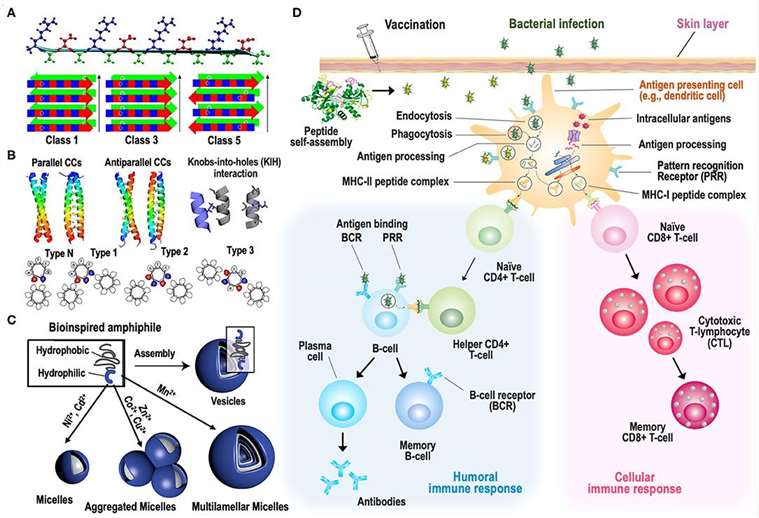Peptides are compounds formed by linking multiple amino acids through peptide bonds, usually consisting of 10-100 amino acid molecules with a relative molecular mass of less than 10,000. Peptides can form a cyclic peptide structure by linking the first and last amino acids together or by forming an intramolecular disulfide bond. Peptide chains can also be formed by non-covalent interactions, such as hydrogen bonding, to form a unique α-helix and β-folding structure, which is like the coil of a spring that extends in a one-dimensional direction. Peptide is an important active molecule in living organisms, which participates in and regulates important physiological processes such as cell proliferation, growth, differentiation, metabolism and apoptosis, etc. The complex process of peptide synthesis and degradation occurs constantly in all living cells.
Peptide drugs are peptides with specific therapeutic effects extracted from chemical synthesis, genetic recombination, and plants and animals, and are specific applications of peptides in the field of medicine. Peptide drugs are characterized by high activity, low dose, and low toxicity, and are widely used in the endocrine system, immune system, digestive system, cardiovascular system, blood system, and musculoskeletal system.
 Fig. 1. Strategies to induce supramolecular self-assembly of peptides and peptide-based vaccines (Frontiers in Chemistry. 2020, 8: 598160).
Fig. 1. Strategies to induce supramolecular self-assembly of peptides and peptide-based vaccines (Frontiers in Chemistry. 2020, 8: 598160).
| Types | Specification |
|---|---|
| Peptide Vaccine | Peptide vaccines are vaccines prepared by chemical peptide synthesis technology by the amino acid sequence of a known or predicted antigenic epitope in the antigenic gene of a pathogen. Since peptide vaccines are completely synthetic, there is no problem of virulence regression or incomplete inactivation. This is especially true for microbial pathogens for which sufficient amounts of antigen cannot yet be obtained by in vitro culture. |
| Anti-tumor Peptides | Peptides have attracted attention in the development of antitumor drugs by their targeting, safety, and specificity, and different peptide drugs have many different mechanisms of action. Different peptide drugs have different mechanisms of action. They can inhibit the proliferation of tumor cells and promote apoptosis to achieve direct anti-tumor effects, and they can also achieve indirect anti-tumor effects by enhancing and stimulating the body's immune response to tumor cells and inhibiting tumor angiogenesis. |
| Peptide-drug Conjugates | Peptides with binding ability are fused with cytotoxins or cytokines, etc., and directed to the lesion site to exert therapeutic effects while reducing toxic side effects. Targeted therapies that selectively bind and act through molecules expressed on the surface of cancer cells are a major advancement in cancer treatment because they are more efficacious and better tolerated than conventional cytotoxic drugs. |
| Cytokine-mimetic Peptides | Cytokine-mimetic peptides refer to peptides that are screened from peptide libraries for their ability to bind specifically to cytokine receptors while exhibiting cytokine activity. The sequence of these mimetic peptides generally differs from the amino acid sequence of cytokines. Cytokines that stimulate hematopoiesis, such as erythropoietin (EPO) and thrombopoietin (TPO), regulate hematopoietic cell self-renewal, proliferation, differentiation, maturation, and programmed death through specific binding to their receptors. |
| Antimicrobial Peptides | Antimicrobial active peptides refer to peptide molecules with antibacterial activity obtained from insects and animals, and hundreds of peptides have been screened. Antimicrobial peptides are characterized by a wide antibacterial spectrum, strong thermal stability, small molecular weight and small immunogenicity, etc. Their unique bactericidal mechanism makes it difficult for pathogenic bacteria to develop drug resistance, and they are expected to develop into a new generation of peptide antibiotics. By designing or modifying natural antimicrobial peptides, we can improve the antimicrobial activity based on eliminating their hemolytic activity and promoting the application of antimicrobial peptides in medicine, which is expected to be developed into a new type of antimicrobial drugs and provide a new way to solve the problem of increasing resistance of pathogenic bacteria to traditional antibiotics. |
| Diagnostic Peptides | Peptides obtained by screening from pathogenic organisms or peptide libraries are used as diagnostic reagents to detect the presence of antibodies against pathogenic microorganisms, parasites, etc. in the body. This includes the detection of antibodies to hepatitis viruses, HIV, rheumatoid diseases, and others. The most important use of peptides in diagnostic reagents is as antigens to detect antibodies to microorganisms such as viruses, cells, mycoplasmas, spirochetes, and parasites such as cysticercus and trypanosomes. |
Peptide drugs are mainly derived from endogenous peptides or other exogenous peptides. Peptides are involved in numerous physiological functions as signaling molecules in the body, so peptide drugs often act as replacement therapies to compensate for the lack of endogenous peptide hormone levels. Endogenous polypeptides are endogenous polypeptides inherent in the body, such as enkephalins, thymic peptides, and pancreatic polypeptides. Examples of exogenous polypeptides are snake venom, salivary acid, bee venom, frog venom, scorpion venom, hirudin, and bactericidal peptides secreted by flies. With the development of modern biotechnology and peptide synthesis technology, some active peptides can be obtained through computerized molecular design and screening, and artificial synthesis.
| CAT# | Product Name | CAS | Sequence |
|---|---|---|---|
| 10-101-295 | Neurokinin A | 86933-74-6 | H-His-Lys-Thr-Asp-Ser-Phe-Val-Gly-Leu-Met-NH2 |
| 10-101-248 | Gramicidin S | 113-73-5 | Cyclo(L-Leu-D-Phe-L-Pro-L-Val-L-Orn-L-Leu-D-Phe-L-Pro-L-Val-L-Orn-) |
| 10-101-20 | Goserelin Acetate | 145781-92-6 | Pyr-His-Trp-Ser-Tyr-D-Ser(tBu)-Leu-Arg-Pro-Azagly-NH2 acetate salt |
| R1574 | Octreotide | 83150-76-9 | Phe-Cys-Phe-Trp-Lys-Thr-Cys-Thr (Disulfide bridge: Cys2-Cys7) |
| 10-101-01 | Tetracosactide Acetate | 16960-16-0 | SYSMEHFRWGKPVGKKRRPVKVYP |
| 10-101-07 | Buserelin Acetate | 57982-77-1 | H-Pyr-His-Trp-Ser-Tyr-D-Ser(tBu)-Leu-Arg-Pro-NHEt.CH3CO2H |
| 10-101-14 | Enfuvirtide | 159519-65-0 | YTSLIHSLIEESQNQQEKNEQELLELDKWASLWNWF |
| 10-101-251 | Ile-Pro-Pro | 26001-32-1 | H-Ile-Pro-Pro-OH |
| 10-101-267 | Arg-Gly-Asp | 99896-85-2 | Arg-Gly-Asp |
Reference